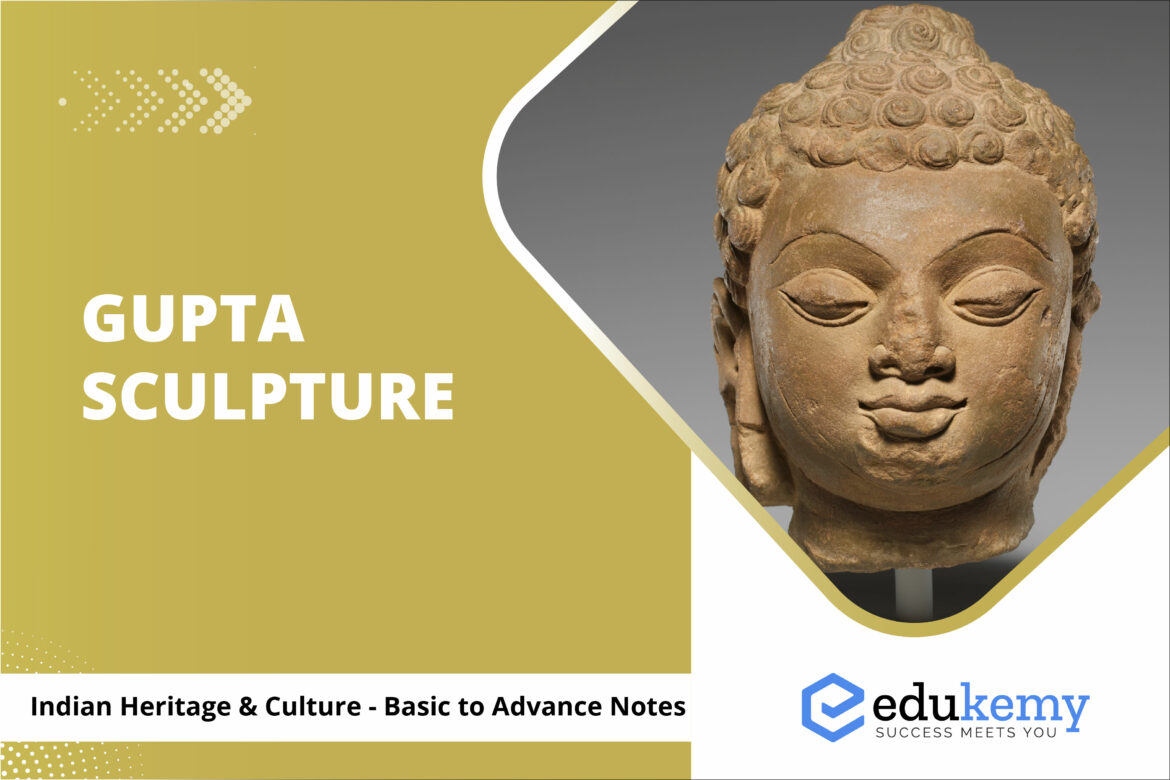
The period of Gupta is often referred to as ‘classic’ due to its unprecedented level of achievement and the perfect balance and harmony it attained in terms of style and iconography. It is widely regarded as the “Golden Age of Indian Art.” Gupta sculptures appear to belong to an entirely distinct realm. The Gupta artist appears to have strived for a loftier ideal, with a new approach to art that emphasizes a closer integration of art and thought, outer forms, and inner intellectual and spiritual concepts of the people.
Contents
- 1 Features of Gupta sculpture
- 2 FAQs
- 2.1 Q1: What are the key characteristics of Gupta Dynasty art?
- 2.2 Q2: How did Greek sculpture influence art in India?
- 2.3 Q3: Who is Subodh Gupta, and what is notable about his sculptures?
- 2.4 Q4: What is Gupta numismatic art, and what makes it significant?
- 2.5 Q5: Are there any notable cave paintings from the Gupta period in India?
- 2.6 For Admissions, talk to our Mentor – 9811333901, 9811333782
Features of Gupta sculpture
- Gupta’s sculpture centers around the human form, serving as the foundation for a new standard of beauty and an emerging aesthetic ideal.
- This idea is based on a profound understanding of the human body’s inherent softness and flexibility.
- Gupta sculptures feature soft, pliant bodies with smooth, glossy textures that allow for graceful and unencumbered movement.
- Gupta sculptures are known for their intricate drapery and jewelry.
- The fashion of the time was for wet or transparent clinging drapery, particularly for female figures. However, the conscious moral sensibility of the Gupta era kept sensuality in check, and nudity was rarely depicted in their sculptures.
- One of the most extraordinary examples of Gupta sculpture is the magnificent red sandstone Buddha from Mathura, dating back to the 5th century AD. The figure depicts the great Master in all his sublimity, standing with his right hand in Abhayamudra (assuring protection), and holding the hem of his garment with his left.
- The Buddha’s smiling expression, with downcast eyes reflecting spiritual ecstasy, is covered by a robe that delicately drapes over both shoulders and clings to his body. His head is adorned with schematic spiral curls and a central protuberance, and his elaborate halo is decorated with graceful concentric bands of ornamentation.


- The remarkable craftsmanship and majestic serenity of the Mathura Buddha figure were later adopted and adapted by other countries that embraced Buddhism, such as Siam, Cambodia, Burma, Java, Central Asia, China, and Japan.
- Another excellent example of Gupta art is the standing Buddha from Sarnath, which embodies the maturity of Gupta sculpture. Unlike the intricate drapery folds of the Mathura Buddha, the Sarnath Buddha only shows the fringe of his diaphanous robe. The perfectly executed figure, with its serene and spiritual expression, truly captures the essence of this sublime being.
- Sarnath not only brought about a delicacy and refinement of form but also introduced a relaxed posture, with the standing figure slightly bending on its axis. This added litheness and movement in contrast to the columnar rigidity of similar Mathura works.
- The stone carvings from the Deogarh and Udayagiri temples, as well as those from the Ajanta temples, are exceptional examples of figure sculpture in their decorative settings. A prime specimen is the large panel of Sheshashayi Vishnu from the Deogarh temple, depicting the Supreme Being slumbering on the serpent Ananta, the symbol of eternity, during the interval between the dissolution of the universe and its rebirth.

FAQs
Q1: What are the key characteristics of Gupta Dynasty art?
A1: Gupta Dynasty art is renowned for its elegance, balance, and intricate details. It is characterized by the use of classical Indian motifs, particularly in sculpture and architecture. The Gupta period is often considered the “Golden Age” of Indian art.
Q2: How did Greek sculpture influence art in India?
A2: Greek sculpture had a significant impact on Indian art, especially during the Hellenistic and post-Hellenistic periods. It introduced techniques like realistic representation of the human form and drapery, which influenced the development of Indian sculpture.
Q3: Who is Subodh Gupta, and what is notable about his sculptures?
A3: Subodh Gupta is a contemporary Indian artist known for his use of everyday objects in his sculptures, often exploring themes of globalization and cultural identity. His work combines traditional Indian elements with a modern twist, making a strong statement in the art world.
Q4: What is Gupta numismatic art, and what makes it significant?
A4: Gupta numismatic art refers to the art of coinage during the Gupta Empire. These coins often featured images of rulers, deities, and inscriptions. They are significant not only for their historical value but also for their artistic merit, showcasing intricate design and details.
Q5: Are there any notable cave paintings from the Gupta period in India?
A5: Yes, the Ajanta Caves in Maharashtra, India, are famous for their exquisite cave paintings that date back to the Gupta period. These paintings depict scenes from the life of the Buddha, as well as various aspects of ancient Indian society and culture. They are considered some of the finest examples of Indian classical art.
For UPSC Prelims Resources, Click here
For Daily Updates and Study Material:
Join our Telegram Channel – Edukemy for IAS
- 1. Learn through Videos – here
- 2. Be Exam Ready by Practicing Daily MCQs – here
- 3. Daily Newsletter – Get all your Current Affairs Covered – here
- 4. Mains Answer Writing Practice – here
Visit our YouTube Channel – here

